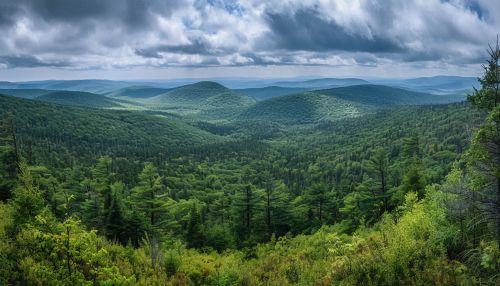Catskill Mountains
Geography
The Catskill Mountains, also known as the Catskills, are a physiographic province of the larger Appalachian Mountains, located in southeastern New York State. The region's boundaries extend approximately from the Hudson River in the east to the West Branch of the Delaware River in the west, and from the Mohawk River in the north to the state line of Pennsylvania in the south.


The Catskills are a mature dissected plateau, an uplifted region that was subsequently eroded into sharp relief. They are largely made up of sedimentary rocks of Devonian age, and are noted for their popular hiking and skiing destinations.
Geology
The Catskills are a geologically complex area, with a long history that has shaped the region's distinct features. The bedrock of the Catskills is dominated by sedimentary rocks of the Devonian period. These rocks, which include sandstone, shale, and conglomerate, were deposited in a shallow sea that covered the region approximately 380 to 340 million years ago.
Over time, these layers of sediment were buried, compacted, and solidified into rock. The uplift and erosion of these rocks have resulted in the Catskills' characteristic tableland appearance, with high peaks and deep valleys. The region is also characterized by its many waterfalls, the result of differential erosion of the layered bedrock.
Flora and Fauna
The Catskill Mountains are home to a rich variety of flora and fauna, thanks to the region's diverse habitats and climates. The region's forests are predominantly deciduous, with species such as sugar maple, American beech, and yellow birch being common. Coniferous forests, composed mainly of eastern hemlock and several species of pine, are also found in the region.
The Catskills are also home to a diverse array of wildlife. Common mammalian species include white-tailed deer, black bear, and eastern cottontail rabbit. The region is also a critical habitat for many bird species, including the bald eagle, red-tailed hawk, and a variety of songbirds.
History
The Catskills have a rich history, with human habitation dating back thousands of years. The region was originally inhabited by Native American tribes, including the Lenape and the Mohicans. European settlers arrived in the 17th century, and the area became an important source of timber and tanning materials.
In the 19th century, the Catskills became a popular destination for artists and writers, who were drawn to the region's natural beauty. This period, known as the Hudson River School, had a significant impact on American art and literature.
In the 20th century, the Catskills became known as a popular resort area, with many hotels and summer camps. Today, the region is a popular destination for outdoor recreation, including hiking, fishing, and skiing.
Recreation
The Catskill Mountains offer a wide range of recreational opportunities, from hiking and camping to fishing and hunting. The region is home to several state parks, including the Catskill Park, a 700,000-acre area that contains some of the most rugged and remote wilderness in New York State.
The Catskills are also a popular destination for winter sports. The region is home to several ski resorts, including Hunter Mountain and Belleayre Mountain, which offer a range of slopes for skiers and snowboarders of all levels.
